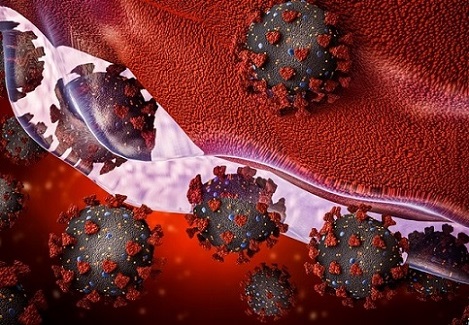Nikhil Prasad Fact checked by:Thailand Medical News Team Apr 28, 2025 1 hour, 56 minutes ago
Medical News:
Scientists Reveal How a Tiny Viral Protein Sabotages Growth, Metabolism, and Regeneration in Human Cells
In a groundbreaking study, researchers from the Department of Neurofarba and the Department of Experimental and Clinical Medicine at the University of Florence in Italy, along with experts from G.E.A. Green Economy and Agriculture Centro per la Ricerca in Pistoia, have uncovered alarming new evidence about how the SARS-CoV-2 virus continues to harm human health at the cellular level.
 SARS-CoV-2 Envelope Protein Quietly Destroys Human Cell Health
SARS-CoV-2 Envelope Protein Quietly Destroys Human Cell Health
The research focused on the virus's envelope, or E, protein — a tiny structural component that plays a big role in helping the virus survive and spread. Using advanced laboratory models, scientists engineered human embryonic kidney cells (HEK293) and human induced pluripotent stem cells (hiPS cells) to permanently express the E protein. Halfway through the second paragraph, this
Medical News report must highlight that the findings demonstrate the E protein’s shocking ability to drain calcium stores inside cells, severely disrupting their normal functions. These disruptions extend to energy production, stress management, and even the vital ability of stem cells to regenerate and repair tissues.
How the E Protein Undermines Cells from Within
The team discovered that, once inside human cells, the E protein settles largely in the endoplasmic reticulum (ER) and related compartments like the ERGIC and Golgi apparatus, rather than staying near the outer membrane. In HEK293 cells, a small portion did make it to the plasma membrane, forming ion channels that allowed potassium to leak out — a process that was blocked by the antiviral drug amantadine. However, the most devastating effects were seen deep inside the cells.
Calcium imaging experiments revealed that cells expressing the E protein lost huge amounts of calcium from their ER stores. This depletion is no small matter — calcium is vital for countless cellular operations. Its loss triggered a cascade of negative consequences, including reduced mitochondrial energy production, slower cell proliferation, and the initiation of ER stress responses.
Severe Impact on Stem Cell Functions
The findings were even more concerning when tested on hiPS cells, a model for regenerative cells in the human body. In these cells, the E protein did not reach the plasma membrane at all but remained trapped within internal structures. Even without forming external pores, the E protein drained the cells’ calcium reserves, leading to severe mitochondrial dysfunction and significantly reducing the cells’ ability to grow and divide.
While the infected stem cells retained their basic "stemness" — they could still express markers like Oct4 and Nanog — their ability to differentiate into new tissue types was compromised. Specifically, while development into ectodermal (brain and skin) and endodermal (gut and lung) tissues remained relatively
unaffected, differentiation into mesodermal tissues — the cells that become muscles, bones, and the cardiovascular system — was markedly impaired.
This loss of mesodermal potential has enormous implications. Since mesodermal progenitors are essential for organ repair and maintenance, the E protein’s damage could help explain why so many COVID-19 survivors experience lingering heart, lung, and muscle problems.
New Clues Behind Long COVID and Organ Damage
The evidence suggests that even in the absence of active viral replication, the stable presence of E protein inside human cells can trigger stress, reduce energy production, block cell proliferation, and prevent effective tissue regeneration. These findings could explain some of the persistent symptoms of long COVID, including chronic fatigue, heart damage, and multi-organ dysfunction.
If confirmed in living organisms, these discoveries point to the E protein as a major hidden driver of long-term COVID-19 health issues. Furthermore, this study highlights the urgent need to develop therapies that specifically block the E protein's harmful actions within host cells.
Conclusions
The study clearly shows that the SARS-CoV-2 E protein is much more than a structural helper for the virus. By disrupting intracellular calcium balance, inducing ER stress, impairing mitochondrial function, slowing proliferation, and selectively damaging the ability of stem cells to regenerate vital tissues, the E protein emerges as a major factor contributing to long-term damage after COVID-19 infection. These findings provide strong justification for future treatments targeting E protein activity to help prevent chronic post-COVID health issues.
The study findings were published in the peer-reviewed journal: Cell Calcium.
https://www.sciencedirect.com/science/article/pii/S0143416025000417
For the latest COVID-19 News, keep on logging to Thailand
Medical News.
Read Also:
https://www.thailandmedical.news/news/new-concerns-about-bone-health-after-covid-19
https://www.thailandmedical.news/news/covid-19-alters-the-human-spleen-and-can-cause-spleen-ruptures
https://www.thailandmedical.news/news/american-study-discovers-that-covid-19-alters-heart-glycosylation-leading-to-potential-cardiac-complications
https://www.thailandmedical.news/articles/coronavirus
https://www.thailandmedical.news/pages/thailand_doctors_listings
